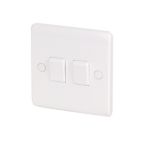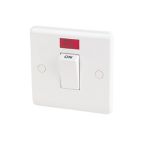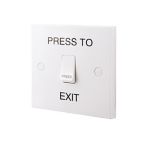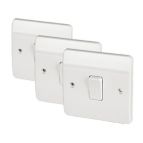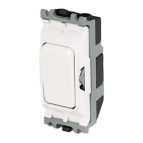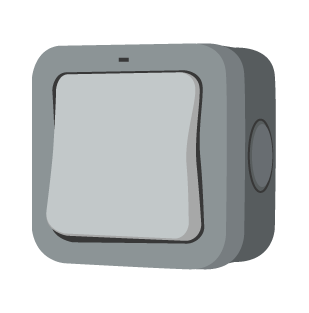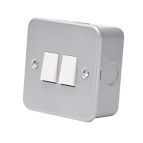Light switch and electrical switch buying guide
Light switch and electrical switch buying guide
Introduction
Buying light switches seems like an easy purchase, but when faced with all the options, you may realise it’s not as simple as you think. So, before you buy, it’s worth doing your research to ensure you get the right switches for your needs.
This buying guide tells you all you need to know about light switches. It covers how they work, what ‘gangs’ and ‘ways’ mean and the types and styles of light switches available. We also look at other types of switches and give tips on fitting light switches and things to consider before buying.
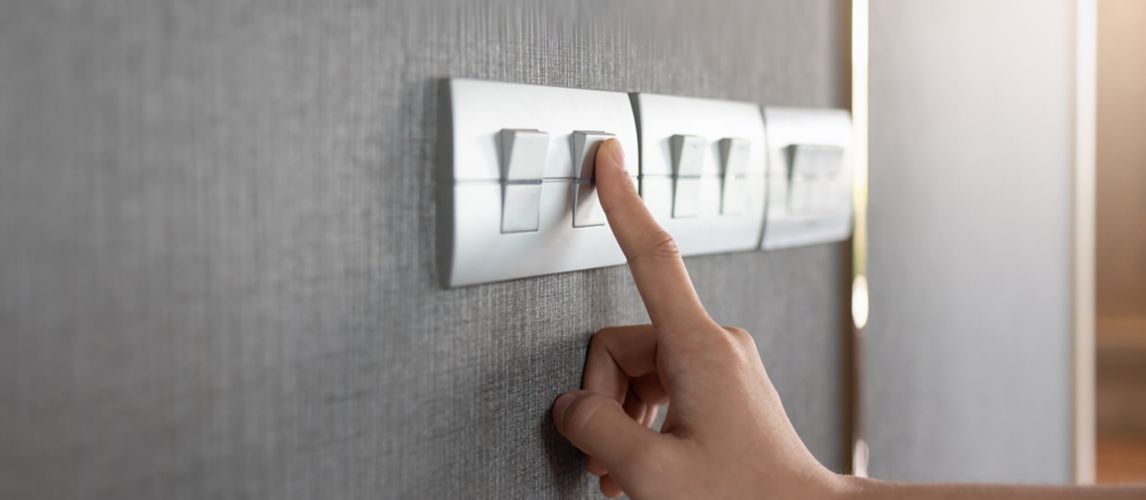
How does a Light Switch Work?
Light switches are made up of three main parts:
- A backplate is recessed into a wall
- The electrical wiring is housed inside the backplate
- A faceplate is the visible part with the switch.
The wires within the switch are connected to the home’s consumer unit and light fitting through electrical cables hidden in the walls and ceilings. The faceplate is then wired to the backplate to form an electrical circuit. Flicking the switch to the off position breaks the circuit, so the light goes off.
There are many types of light switches available. Some only control a single light, while others can have multiple switches to control multiple lights from one place.
Homeowners or businessowners often replace their light switches simply because they want to update them to suit their room décor. But, for safety, they should be replaced if they’re showing any of the following signs of wear and tear:
- Crackling or popping sounds when the switch is on
- The switch or faceplate feels hot
- A delay between flicking the switch and the light coming on
- The switch feels loose
Understanding Switch ‘Gangs’ and ‘Ways’
Gangs and ways are the terms used to describe light switch connections. They tell you how many light fittings the switch can control and how many other switches control the same light. Here’s an explanation.
- Gangs: The number of gangs refers to the number of switches on a single faceplate. Each switch operates a different light fitting. So, a 1-gang light switch has one switch which controls one light. A 2-gang light switch has two switches to operate two lights, and so on. Light switches are available with 1 to 4-gangs
- Ways: The number of ways refers to the number of switches that control one light. For example, a 1-way switch controls one light from one switch. A 2-way switch controls one light, but the same light can also be controlled with another connected 2-way switch. So, 2-way switches work in pairs, and 3-way switches (or intermediate switches as they’re known) work in threes. Switches with multiple ways are used where there are several entrances to a room or in stairwells, where the light can be controlled from separate switches at the top and bottom of the stairs. Light switches are available with 1 to 3-ways, but it’s worth noting that 2 or 3-way switches can also be wired for 1-way use.
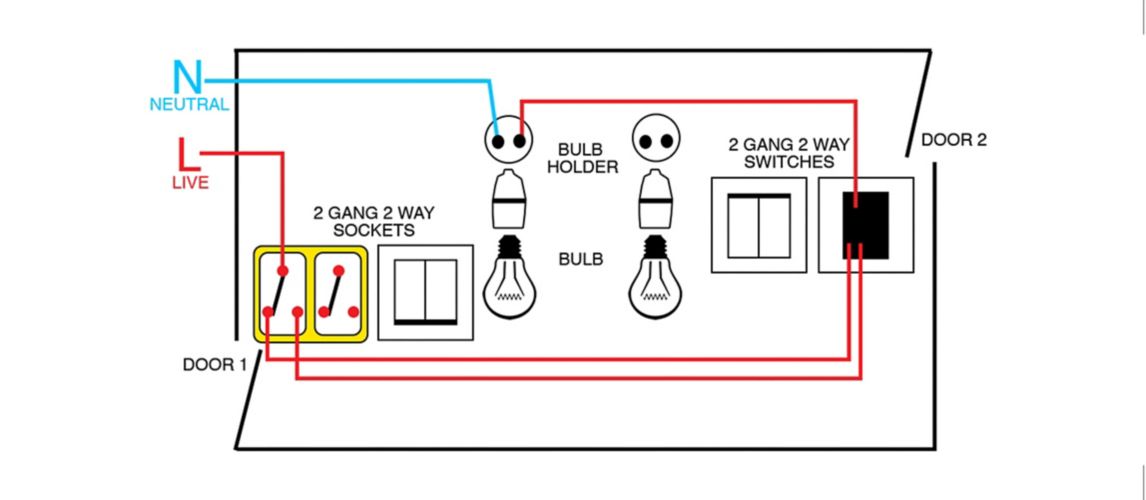
Types of Switches
There are many types of light switches available, but there are other types of switches too. In this section, we run through all the different types of switches you’ll find around the home and businesses to help you find the right one for your needs.
Types of Light Switches
Light switches come in many different types which suit different kinds of rooms and uses as follows:

White light switches are the most common type of light switches fitted in UK homes and businesses because they’re practical and suit any style of décor. They come in many forms, including all the options shown in this section.
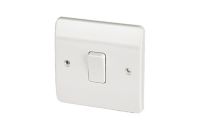
Single light switches are 1-gang switches used to control one light fitting. 1-way single light switches can be used in rooms with a single entrance and one light. Or multiple 2 or 3-way single switches can be used in rooms with one light and multiple entrances. They’re available as dimmer, rocker and toggle switches (see below).

Double light switches, also known as 2-gang switches, have two switches on the faceplate which control two light fittings. 1-way double switches can be used in rooms with a single entrance and two light fittings. Or two 2-way double switches can be used in rooms with two lights and two entrances. They’re available as dimmer, rocker and toggle switches (see below)
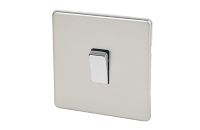
Rocker light switches work like any standard light switch, except the switch rocks between the on and off position in a see-saw motion. They can be used in any room of the home and are available in up to 4-gangs and 3-ways
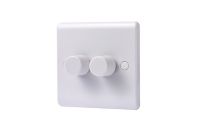
Dimmer light switches are used to vary the brightness of the bulb they’re controlling to create mood lighting. The most common dimmers have a rotating knob that increases or decreases the amount of power the light bulb gets, making the bulb brighter or dimmer. The knob can also be pressed to turn the light off and on. Other types of dimmer switches have push or touch buttons instead of a knob. Dimmer switches are often used in rooms where people relax, such as living rooms and bedrooms
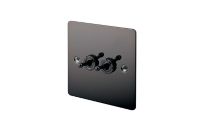
Toggle switches operate by using a manual lever that’s pushed up and down to turn lights off and on. They’re often called dolly switches and replicate the more traditional style found in older properties. But they can also be fitted in modern homes to add a vintage finish. They can be used in any room of the house.
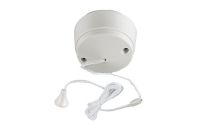
Pull cord switches are also known as bathroom light pulls, or light pull cords. They have a base plate mounted to the ceiling with a suspended string that turns the light on and off when pulled. Building regulations state these are the only type of switches that can be installed in bathrooms and wetrooms. They're designed to keep the user away from the electrical circuit to minimise the risk of electric shocks.
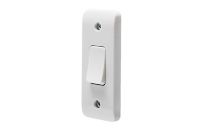
Architrave switches are narrow light switches designed to fit on door frames, either because space is tight or because they're less intrusive. They come with standard or rocker switches.
Smart Switch Types
Smart light switches are like standard light switches, but with the added benefit of internet connectivity. Using WiFi, they connect to an app on a smartphone or tablet and allow users to turn lights on and off any time, from anywhere, automate them with schedules or set timers. They can also be connected to other smart devices as part of a more extensive smart home system. Read our smart plugs and switches buying guide to find out more.
Smart light switches offer many benefits. For example, they can help reduce energy bills because users can check to ensure lights have been turned off when they’re not at home. Some even have built-in energy monitors. They also increase security as lights can be turned on remotely at night to deter burglars if no one is home. And they offer convenience because lights can be controlled with a voice command through a smart speaker.
Smart light switches are available with dimmer functions and come in 1 or 2-ways and up to 4-gangs.
Appliance Switch Types
Appliance switches are installed in kitchens, utility rooms and bathrooms. They are used to control power to appliances, such as cookers, washing machines and dishwashers. They’re typically installed in easy to reach areas, such as above a worktop because the location of the appliance would otherwise make access to the power source difficult.
There are many types of appliance switches available. Some come pre-labelled with the name of the appliance, making it quick to identify when the power needs to be switched off in an emergency. Pull-cord versions are available for bathrooms to control electric showers and extractor fans. Some faceplates combine appliance switches with a switched socket. And many come with red lights to indicate when the power is switched on. Appliance switches are available in a choice of styles and finishes, so a suitable switch can be found to suit any home’s décor.
Retractive Switch Types
itches are mainly used in commercial settings for operating door openings or bell systems. The switch is only on while the button is being pressed. Once the button is released, the switch automatically returns to its original position and goes off. In a home setting, these switches can be used, for example, to control electric garage door openings or in flats where a communal door needs to be opened to let visitors in.
Retractive switches look like standard light switches and come in various styles and finishes. Some retractive switches, designed for commercial use, have words such as ‘press to exit’ printed on them.
Intermediate Switch Types
An intermediate switch is simply another name for a 3-way switch. Three of these switches are used together to control a single light from three locations. This makes them ideal for stairways, long hallways and large open plan spaces.
Intermediate switches look like standard light switches are available with a rocker or wide rocker switch. They also come in various styles, colours and finishes to suit any décor.
Switched Fused Spurs
A switched fused spur is another type of switch used for electrical appliances such as washing machines and boilers. It contains an individual fuse that protects the appliance it's directly wired to by breaking the connection if excess current is detected. As well as the fuse, these switches also have a rocker switch, so the appliance can be manually switched off as required.
Switched fused spurs are available in a choice of styles and finishes to suit any decor. Some come pre-labelled with the name of the appliance, making it quick to identify when the power needs to be switched off in an emergency. And many come with red lights to indicate when the power is switched on.
Grid Switch Types
Grid switches are single light switches that can be pushed into a grid frame. You can combine several switches on one grid frame to create a bespoke light switch panel. These switches can control any light or appliance in a home.
Grid switches are available as 1 or 2-way switches and dimmer switches, with a choice of styles and finishes to suit any decor. There are also appliance varieties, which have the appliance name printed on them.
Outdoor Switch Types
Outdoor switches are installed on exterior walls and are used to control outdoor electrics such as lighting, water features and electronic gates. The switches are designed to be weatherproof, and they all carry an IP (ingress protection) rating to indicate how weatherproof they are. The IP rating is shown using the letters IP, followed by two numbers. The first number (a 5 or 6) indicates dust resistance, and the second number (a 5, 6 or 7) indicates water resistance. The higher those numbers are, the more resistant they are.
Outdoor switches are typically grey and have wide rocker switches, although some have standard switches. They are available with up to 4-gangs and 2-ways.
Metal Clad Switch Types
Metal clad switches are heavy-duty, durable switches designed to withstand high usage and accidental damage. For this reason, they’re ideal for use in industrial and commercial settings to control lights and appliances.
Metal clad switches have metal faceplates and are available with up to 3-gangs and 2-ways.
Choosing Switch Colours and Finishes
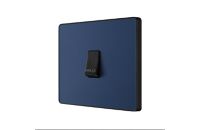
The most common light switches are white plastic. But there’s a wide range of other, more decorative colours and finishes available, so homeowners can match their switches to their décor.
For example, other light switch colours available from Screwfix include black, brown, cream, grey and blue. Then there are metal effect switches, such as steel, brass, bronze, chrome, copper, iridium, and silverl. These metal effects can come in different finishes, such as gloss, matt, antique, brushed, polished or satin. Finally, there are even some more unusual switches, such as glass switches and wood effect switches.
Switches also come with different profiles, describing how the switch stands out from the wall. For example, raised profiles with rounded or square edges stand a few millimetres out from the wall. There are slim raised profiles that stand out less. And there are flat profiles that are almost flush with the wall.
And finally, switches can be screwed or screwless. On screwed switches, the screws are visible. But a screwless switch has a clip-on faceplate which means there are no visible screws.
Fitting a Light Switch
Fitting a light switch can be a simple or complex task, depending on what light switches you're replacing or adding.
For example, carrying out a like-for-like replacement of a 1-way switch is a simple task for a competent DIYer. It involves removing the faceplate of the old switch and fitting the new one. You can take a photo of the wiring in the old switch to make connecting light switch wires in the new one easier. Also, keep hold of the old screws – modern switches come with metric-sized screws, while old fittings use imperial-sized screws. So, you may need to use the old screws to fit the old backplate.
Three or two way light switch wiring may be more complicated. A like-for-like replacement should be easy for a competent DIYer. However, caution should be taken when working on multi-way switches. The lights they control should be connected to the same circuit, but there may be live cables on another switch if they're wired incorrectly.
Swapping a 1-way switch for a multi-way switch is more complicated. It involves replacing the original switch, installing other multi-way switches at the other control points, and running a cable between them to connect them. This is a job that's best carried out by a qualified electrician.
4 Things to Consider Before Buying Switches
It’s always important to do your research before buying switches to ensure you’re getting the right product for your needs.
Here are four other things to consider:
1. How many separate light fittings do you want to control?
If you're planning to change or add switches throughout a home, it's worth thinking ahead about how many switches you need to ensure you get the right amount. Go from room to room and count how many lights need to be controlled. Then work out if any of these can be combined on a 2-gang, 3-gang or 4-gang switch and whether, in some cases, you need to control one light with multiple switches.
2. What colour or finish are you looking for?
White plastic switches are often the default switch people go for but consider if other colours and finishes would suit the décor better. For example, brushed or polished chrome or slate grey are perfect finishes to match contemporary décor. Or if the décor is more traditional, there’s antique brass or wood effects. Also, think about how the colours will complement or match other items in the room, such as appliances, door handles or window openings. And don’t forget, you can choose different colours and finishes for different rooms if necessary.
3. Do you want a dimmer switch?
Dimmer switches are ideal for rooms where people want to relax in softer light, such as living rooms and bedrooms. So, consider if a dimmer switch is needed. If so, ensure the light bulb used in the connected fitting is compatible with a dimmer switch. If not, simply change the light bulb.
4. Smart compatibility
If the home already has other smart devices installed (i.e., smart security, plugs, speakers etc.), smart switches can be connected to them to create automation. For example, you can set up an automation where the lights switch off automatically when a room is empty. If there are no other smart devices installed yet, consider what may be needed in future. Either way, always check that smart devices are compatible with each other.

